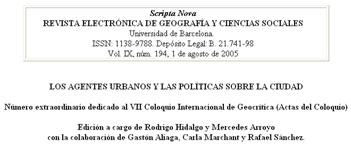Chile’s Central Urban System. Social And Enviromental Challenges
Keywords:
Urban System, Metropolitan Area, Conurbation, Intermediate CityAbstract
It’s situated in Chilean territory, at the beginning of the third millennium. In this system, we can identify three metropolitan areas: Santiago, Valparaíso-Viña del Mar, and Concepción-Talcahuano plus the La Serena-Coquimbo conurbation. The cities of intermediate level continue in range making up to twelve centers of over 100.000 inhabitants. These urban centers are located along the coastal territory to the north of Santiago, whereas to the south we can find what is known as the Intermediate Depression which includes the cities and towns south of Santiago and on which this research was conducted. These urban centers were founded during the period of the colonization of the American Continent. This cities located in the area of the Central Valley are arranged in a pattern of linear integration. These towns are located alongside the two main transportation axes of the country: the Panamerican Highway and the North-to-South railroad. Besides, there can be found the highway network that leads towards the Coast and another which leads towards the Andes linking them to some other small urban centers and their rural hinterland. Not far from each and located between cities of first regional rank such as Rancagua, and Talca correspondingly, which are regional capital cities; we can find towns of second order. These are the capital cities of each province and among them are: San Fernando, Curicó, Linares, Chillán, and Los Angeles followed by some other minor urban centers with a population between 20.000 and 50.000 inhabitants.Downloads
Published
2007-06-07
Issue
Section
Articles
License
Los autores que publican en esta revista están de acuerdo con los siguientes términos:
- Los autores conservan los derechos de autoría y otorgan a la revista el derecho de primera publicación, cin la obra disponible simultáneamente bajo una Licéncia de Atribución Compartir igual de Creative Commons que permite compartir la obra con terceros, siempre que estos reconozcan la autoría y la publicación inicial en esta revista.
- Los autores son libres de realizar acuerdos contractuales adicionales independientes para la distribución no exclusiva de la versió de la obra publicada en la revista (com por ejemplo la publicación en un repositorio institucional o en un libro), siempre que se reconozca la publicación inicial en esta revista.





